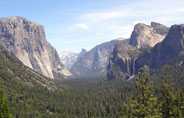Mon 28 Jul 2008
A demonstration to save Point Reyes National Seashore deer; park administration dishonesty officially confirmed
Posted by DavidMitchell under agriculture, General News, History, Marin County, West Marin nature, Wildlife
Comments Off on A demonstration to save Point Reyes National Seashore deer; park administration dishonesty officially confirmed
More than 40 peaceful demonstrators, mostly from West Marin, walked from Sacred Heart Church in Olema to Point Reyes National Seashore headquarters Sunday in a last-ditch effort to discourage the the park from killing its few remaining fallow and axis deer. Despite public opposition, the park two weeks ago announced eradication was about to resume.
Opposition to Park Service plans for killing the fallow and axis deer has been so widespread that National Seashore Supt. Don Neubacher in 2005 temporarily placated the public with assurances that eliminating all 1,000 deer would take 15 years. There would be plenty of time to find other approaches for controlling herd sizes between now and then, he told a public meeting.

But, like so many of Supt. Neubacher’s public statements, the assurance was untrue, and late last fall, the park set out to kill off all 1,000 as quickly as possible.
Moreover, the brutal way in which the first 800 or so deer were killed, many left in the wild to suffer long, agonizing deaths from gut wounds, offended hunters as much as the general public.

Eventually, US Senators Dianne Feinstein and Barbara Boxer, Speaker of the House Nancy Pelosi, three other Bay Area members of Congress, Lynn Woolsey, George Miller, and Anna Eshoo, and Lt. Governor John Garamendi all called for a moratorium on the killing while the use of contraception was studied.
But Supt. Neubacher was as quick to thumb his nose at members of Congress and the lieutenant governor as at members of the public. A bureaucrat who thrives on defiance, Neubacher two weeks ago rejected contraception studies by the Humane Society of the United State, which is willing to help administer the birth control. He instead announced he would proceed with the killing posthaste.
 In trying to justify his nativistic eradication of un-American deer in the park, Supt. Neubacher’s administration, as most West Marin residents realize, fabricated the problems the deer were supposedly causing.
In trying to justify his nativistic eradication of un-American deer in the park, Supt. Neubacher’s administration, as most West Marin residents realize, fabricated the problems the deer were supposedly causing.
The most notable untruth was that the few fallow (right) and axis deer were out-competing the park’s native blacktail deer. In fact, the park and land immediately around it has, if anything, an overabundance of blacktail deer, as evidenced by all the roadkills. (Photo by Janine Warner, founder of digitalfamily.com)
But then, Supt. Neubacher may be one of the most dishonest public officials around that isn’t in prison; witness his deceitful, bully-boy attempts to drive Drakes Bay Oyster Company out of business. Here’s a press release distributed last week by the Business Wire. I’ll be coming back to the topic in future postings:
MARIN COUNTY’S DRAKES BAY OYSTER CO. ABUSED BY GOVERNMENT AGENCY, ACCORDING TO U.S. DEPARTMENT OF INTERIOR INSPECTOR GENERAL REPORT
Business Wire, July 23, 2008
REPORT SHOWS NATIONAL PARK SERVICE USED FALSE INFORMATION, BUREAUCRATIC RED TAPE IN ATTEMPT TO RUIN MARIN COUNTY BUSINESS
SAN FRANCISCO — A report issued by the Office of the Inspector General for the U.S. Department of the Interior has concluded that the National Park Service knowingly used false scientific data to bolster its attempt to drive a local oyster company from the Point Reyes National Seashore area.
The investigation conducted by the Inspector General reveals that Park Service officials made false scientific claims, misled other federal authorities and attempted to hide data that called into question the veracity of the Park Service’s case. The report details how the Inspector General’s Computer Crimes Unit recovered an email apparently deleted by the National Park Service’s lead scientist that showed the government agency was knowingly misrepresenting environmental data.
 Park Service officials are accused of engaging in a campaign of intimidation and disinformation to damage the operation of the Drakes Bay Oyster Company. Investigators concluded there is no scientific evidence to support Park Service claims that the oyster company was responsible for pollution or damage to the environment.
Park Service officials are accused of engaging in a campaign of intimidation and disinformation to damage the operation of the Drakes Bay Oyster Company. Investigators concluded there is no scientific evidence to support Park Service claims that the oyster company was responsible for pollution or damage to the environment.
Drakes Bay Oyster Company was purchased in 2004 by Kevin Lunny [at left with oyster “seed”] along with his brothers, Robert and Joe Jr. The Lunny family owns the Historic G Ranch and has been a fixture of the Point Reyes community for more than 60 years. The Lunnys are committed to organic ranching practices and policies that protect the environment in western Marin County. (Photo by Janine Warner, founder of digitalfamily.com)
The Lunny family says it will now seek “restitution for interference and harm to its business.” The family praised Senator Dianne Feinstein for demanding justice in this case of alleged government abuse of a small family business.
“With the Inspector General findings, we at last have vindication of the Lunny family after four years of frustration and government abuse,” said Sam Singer, a spokesman for the Drakes Bay Oyster Company. “The Lunnys purchased Drakes Bay Oyster Company with the full intent of restoring a Point Reyes business and contributing to an important local industry. What the National Park Service tried to do here in misleading the Marin County Board of Supervisors and penalizing citizens at the expense of the truth was nothing short of outrageous.”
“This report shows that the National Park Service under the jurisdiction of the U.S. Department of the Interior fabricated and falsified the science to drive Mr. Lunny and his family out of business,” said Mr. Singer. “This report is devastatingly critical and calls into question Interior Secretary’s Kempthorne’s newly announced ethics policy. We expect wholesale changes in the Department to come from this unfortunate episode.”
 In April 2007, Park Service officials had threatened to seek civil and criminal charges against the Lunnys, claiming that their oyster beds were harming seals, damaging eelgrass and polluting waterways. “Based on the research conducted by several scientists, the Inspector General concluded that the data used by the Park Service was flawed and unreliable,” said Mr. Singer.
In April 2007, Park Service officials had threatened to seek civil and criminal charges against the Lunnys, claiming that their oyster beds were harming seals, damaging eelgrass and polluting waterways. “Based on the research conducted by several scientists, the Inspector General concluded that the data used by the Park Service was flawed and unreliable,” said Mr. Singer.
[Kayakers use the oyster company premises for a haulout site.]
“My family and my business have been harmed,” said Kevin Lunny. “The Inspector General detailed numerous instances where science was manipulated, facts were distorted, and false accusations were made. All we wanted to do was improve a local oyster company and contribute to the Point Reyes community. We are encouraged by the Inspector General’s report but the federal government has farther to go in atoning for what happened here. The Park Service has broken trust and good faith with the ranchers, farmers, and citizens of West Marin.”
“In the end, this is about private citizens standing up to abusive treatment by their government,” Mr. Lunny said. “We said all along that the Park Service was in the wrong and now we have been proven right. The Lunny family has lived, farmed, and ranched in Point Reyes for more than six decades. We supported the Seashore’s creation and enjoyed an outstanding relationship until recently. It is our hope and prayer that the Park Service will work with us to reestablish a positive relationship.”


 Not only do the Knights of Malta have their own license plates, I read last week that they issue their own passports, have their own flag (right), stamps, and currency, actually are widely recognized as sovereign, and have diplomatic relations with 99 countries.
Not only do the Knights of Malta have their own license plates, I read last week that they issue their own passports, have their own flag (right), stamps, and currency, actually are widely recognized as sovereign, and have diplomatic relations with 99 countries.
 The Science Conservation Center in Montana, meanwhile, has written a rebuttal to the Audubon Society, saying that contraception would be better than killing to control the number of wild horses. But BLM itself, The Times reported, stands accused of having little interest in contraception.
The Science Conservation Center in Montana, meanwhile, has written a rebuttal to the Audubon Society, saying that contraception would be better than killing to control the number of wild horses. But BLM itself, The Times reported, stands accused of having little interest in contraception.





 All this commotion suggests that seeking solitude in nature to restore your soul can sometimes be more romantic than realistic — whether you’re wandering on Point Reyes or in Yosemite (right). Even without climbers and their fans, Yosemite’s wilderness is crawling with an estimated 500 black bears. If you don’t want your meditations disturbed, it’s better to follow the Savior’s advice (Matthew 6:6), and “when thou prayest, enter into thy closet.”
All this commotion suggests that seeking solitude in nature to restore your soul can sometimes be more romantic than realistic — whether you’re wandering on Point Reyes or in Yosemite (right). Even without climbers and their fans, Yosemite’s wilderness is crawling with an estimated 500 black bears. If you don’t want your meditations disturbed, it’s better to follow the Savior’s advice (Matthew 6:6), and “when thou prayest, enter into thy closet.” My kitchen door has become a regular stop on Mrs. Raccoon’s evening rounds.
My kitchen door has become a regular stop on Mrs. Raccoon’s evening rounds.

 Late in the evening, a male raccoon (left) sometimes shows up begging, but he’s more skittish and is easily intimidated by Mrs. Raccoon if she’s around. Which is probably why he usually waits until she’s gone.
Late in the evening, a male raccoon (left) sometimes shows up begging, but he’s more skittish and is easily intimidated by Mrs. Raccoon if she’s around. Which is probably why he usually waits until she’s gone.


 Digging up the roses was an amazing experience. It took a pick, as well as a shovel, to free them, for they were not growing in topsoil, as you and I think of it.
Digging up the roses was an amazing experience. It took a pick, as well as a shovel, to free them, for they were not growing in topsoil, as you and I think of it.

